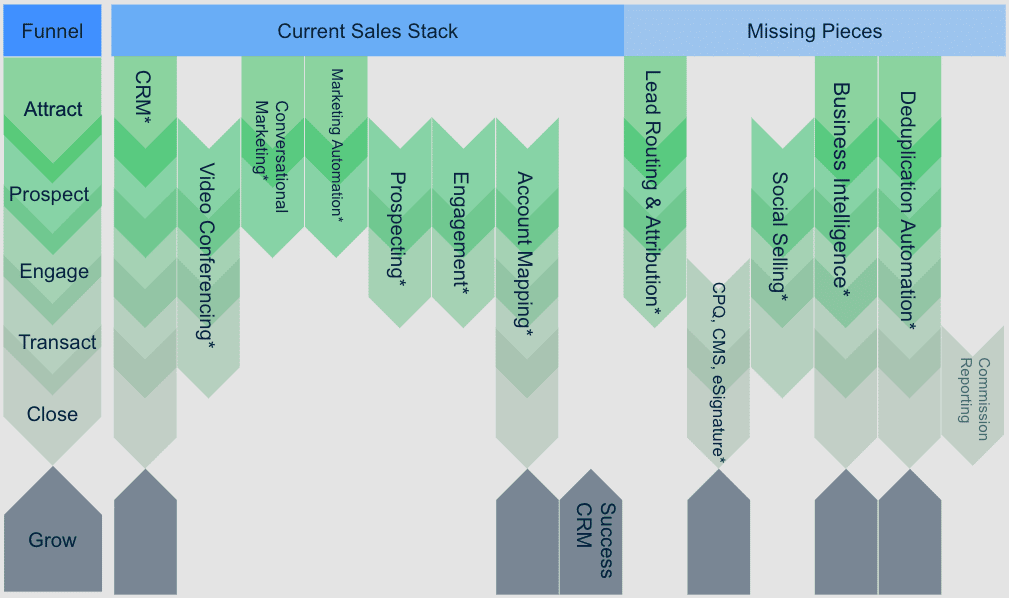When you’re building your GTM team’s technology stack, things can easily spiral out of control without a strategy. New systems are added without consideration for where they fit within the bigger picture. Sharing data is clunky and complicated. And making a change in Salesforce can easily break workflows in other systems.
The ideal tech stack, on the other hand, works harmoniously. Each tool serves a particular purpose, systems communicate seamlessly, users feel confident in data accuracy, and no one spends time on manual workarounds. Here’s how to begin working towards that ideal scenario
What is a Go-To-Market Tech Stack?
A tech stack is the portfolio of systems an organization uses as part of their day-to-day workflows. Technology is ubiquitous in every field these days, and even small businesses use an average of 40 SaaS apps.
An average technology stack includes systems that are used broadly (such as internal messaging) and those that are highly specific to a certain team or individual role (such as social media analytics). Because today’s businesses are digitally dependent, especially with the rise of remote work, it’s critical for companies to view their tech stack holistically, and not in individual pieces.
What makes a tech stack effective?
An effective GTM technology stack is flexible enough to allow you to adopt new tools as you need to. At the same time, systems that need to communicate with one another need to be able to do so seamlessly.
Many companies choose to purchase systems that help overcome gaps in communication and processes between systems. For example, using Sonar’s Salesforce change mangement platform, you can see how systems impact one another and prevent costly, time-consuming mistakes when you make changes.
A few attributes that make a GTM tech stack effective include:
- The ability to integrate with existing tools and systems
- Helps to uphold pristine data quality, mitigate common data quality issues, and reduce tech debt
- A user-friendly interface and ease of use
- Allows your team to scope out potential issues and quickly fix them
- Customization options to meet business needs
- Reliability, scalability and security
- Allows you to document metadata and remain compliant
- The ability to track, measure and analyze data
- Strong customer support and community
The hierarchy required to make your GTM tech stack more effective
Building and maintaining an effective tech stack requires consistent oversight. How are your tools working together? Are they communicating effectively? How will new tools impact your current workflows? This is where investing in the ideal RevOps team structure becomes critical to your organization’s success. Oftentimes, individual employees or teams consider new tech purchases from a siloed perspective. It’s best to make someone responsible for helping guide those decisions to break down GTM silos and keep everyone aware of the bigger picture.
What Makes a Go-To-Market Tech Stack Effective?
Building and maintaining an effective tech stack requires consistent oversight. How are your tools working together? Are they communicating effectively? How will new tools impact your current workflows? Oftentimes, individual employees or teams consider new tech purchases from a siloed perspective. It’s best to make someone responsible for helping guide those decisions and keep everyone aware of the bigger picture.
Using a GTM Technology Stack Diagram to Manage Your Tools
Even with one person or team providing oversight into your tech stack, you need a framework to help you visualize overlaps and points of dependency. This awesome tech stack diagram from our friends at Onna is a great example:

With this framework, you can get a bird’s-eye view on:
- What your current tech stack includes
- How it aligns to your customer journey
- Discern which functions are missing
Here’s how Kevin uses the diagram:
“Every dollar I spend needs to have an ROI story behind it, so it’s important that I truly understand what I’m buying and the purpose it serves within our GTM organization. To do this, I find it incredibly valuable to visualize my tech stack, both current and future state, across my entire sales funnel. This is a great way to identify what I call tool bloat – too many platforms that provide overlapping solutions. This process also allows me to craft more intelligent business cases to present to internal leadership when I need to make a purchase.”
Utilizing the GTM Tech Stack Diagram
As you can see, the diagram is broken out into three sections:
- Stages of the customer journey
- Current tools (listed by functionality)
- Missing pieces
Looking at the diagram vertically, you can see whether each tool supports the stages of the customer journey on the left.
Here’s why this is so valuable:
→ Gives leaders the big picture: Utilizing this diagram, RevOps teams and leaders who are charged with overseeing the tech stack and easily pinpoint gaps in their operations.
→ Seeing how tools fit: Much like a puzzle, individual contributors and teams can use this chart before adding new technologies to easily see where potential tools fit within the broader GTM tech stack.
→ Getting leadership buy-in: Helps leaders to see that you’re missing a vital system or if your current system doesn’t adequately cover every stage of the customer journey, they’re more inclined to understand the need.
→ Streamline onboarding: When new employees join the company, the diagram can help them easily see which systems you have in place and how they interact with one another.
Conclusion: A Recipe for GTM Team Tech Stack Success
As your needs evolve, and as new tools become available, adopting new technologies is inevitable. Even once you’ve created an ideal tech stack, it’s important to continually make sure it’s performing as you need it to. Using this tech stack diagram will help you easily evaluate the nice-to-have tools from the need-to-have tools.
As you think about tools that will ultimately allow your teams to work smarter not harder, check out Sonar. Sonar delivers the Ops toolkit you need to make Salesforce changes with precision. Allow your teams to spend less time troubleshooting and more time delivering high-growth projects. Think of it as your Blueprint for managing change among your GTM tech stack. Click here to try a free trial today.

